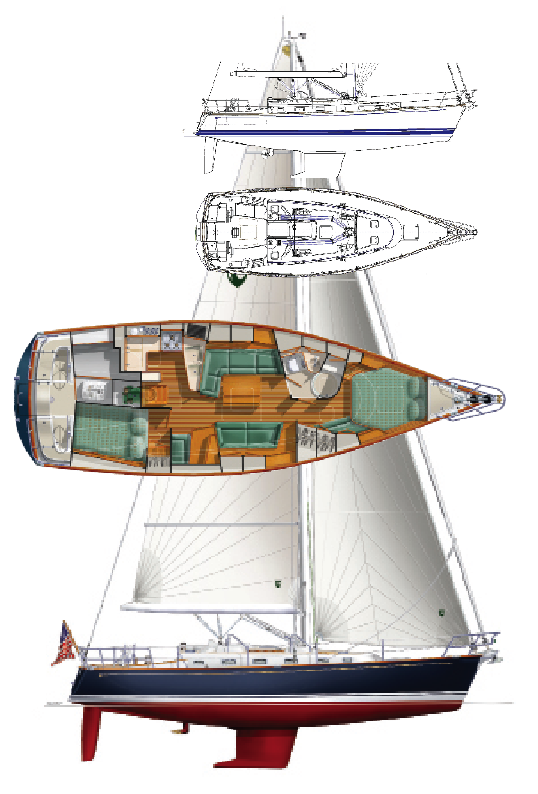Tartan 4000
Here's a great looking boat from the Tartan design group led by Tim Jackett. The approach to the styling of the Tartan is in stark contrast to that of the Feeling. If the Feeling reflects the Euro approach to styling the Tartan is pure Americana, and I like it.
The hull lines show a midsection with 13 degrees of deadrise and a nice firm, turn to the bilge for good stability. Deadrise in a cruising boat has its advantages. It makes the hull stiffer. It provides a natural sump to the bilge and it gives more depth for floors and internal structure. The stern is broader than I like to see but when you look at the cockpit layout it will make sense. The D/L is 172. The L/B is 3.13, almost identical to the Feeling. You can choose from three draft options: a fin keel at 7 feet, 6 inches; a beavertail at 5 feet, 11 inches; and a keel/centerboard at 4 feet, 9 inches with the board up. Numbers here are based upon the beavertail displacement. It's a good-looking hull with a half-angle of entry of 19.5 degrees, a very moderate number.

The accommodation layout of the Tartan uses a lot of angles. I look at the angle and I try to see what is benefited by the angle. I look at this Tartan layout and it works for me. The galley is big. The nav station is more than adequate. The opposing dinette and settee will create that inviting comfortable feel and the forward head is huge. The fore and aft double-berth staterooms are not big but I see them as just places you will retire to to sleep, so why waste space? They have hanging lockers. I think the key to this layout's success may be the lack of a second head. Living with two boys I have always been the toilet cleaner and for me one head is fine.
Deck layouts are getting predictable. I remember racing in 1974 on a Carter 39 that had twin wheels. It was the only boat in Seattle with two wheels. Now twin wheels are the rage because they open up access to the stern boarding area, which is generally a gate cut into the transom and a broad swim platform. This has become important for production boats. The mainsheet traveler is forward to get it out of the cockpit. There is a self-tacking jib track on the cabintop. There are no additional jib tracks on the deck. Give me some additional outboard jib tracks and this deck would be near perfect.
I get a chuckle when I read the sailing websites about alternative rigs. For the best all-around performance on a boat of this size a simple, fractional-rigged sloop rig works the best. It is close winded, gives you options and minimizes the strings you have to pull. This rig on the Tartan puts a stay out at the tip of the anchor roller for a light-air genoa or Code zero. No, you can't tack it through that slot. You will have to roll it up and unroll it on the other tack, but with today's furling gear that's easy. The SA/D with the self-tacking jib is 20.5 and that should be fine for decent light-air performance and you can tack up the bay without touching anything but the wheel-or a button.
LOA 40'8"; LWL 36'5"; Beam 13'; Draft 7'6" (fin), 5'11" (beavertail), 4'9" (centerboard); Displacement 20,104 lbs.; Ballast 8,000 lbs.; Sail area 893 sq. ft.; SA/D 20.5; D/L 172; L/B 3.13; Auxiliary Volvo D2 55-hp; Fuel 50 gals.;
Water 100 gals.
Tartan Yachts
One High Tech Ave., Painesville, OH 44077
(440) 357-7777
www.tartanyachts.com
Our Best Estimate of the sailaway price
o.b.e. $500,000

Comments